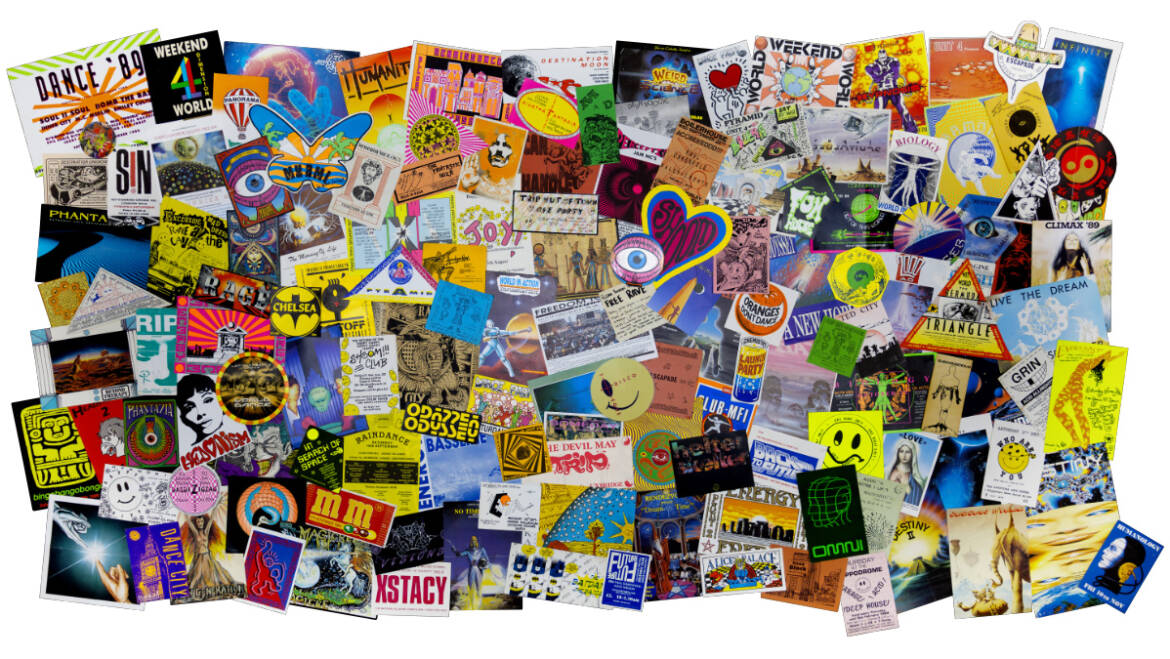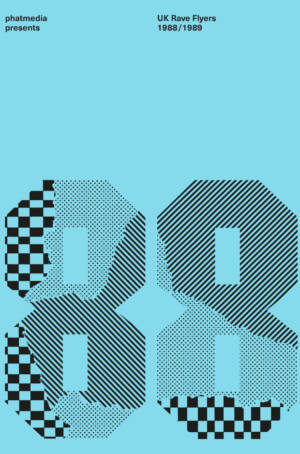In this guest post, Dave Nicholson, founder of phatmedia and author of the forthcoming book phatmedia presents UK Rave Flyers 1988-1989, explores the rarest and most sought-after flyers from the UK’s Second Summer of Love, and the stories behind these iconic artefacts of rave culture.
In 1988 and 1989, simple bits of photocopied or screen-printed paper became iconic relics of UK rave culture. What began as throwaway event flyers are now coveted artefacts, with collectors hunting them down and prices steadily climbing on eBay and through private sales.
For over 25 years, phatmedia has been preserving and documenting these fragments of rave history. Home to the UK’s largest collection of original acid house and rave flyers, the archive captures the explosive creativity and underground energy of a defining cultural movement.
What started in 1998 as a personal collection has evolved into a community-led website featuring more than 22,500 flyers spanning 1985 to the early 2000s. Curated and maintained by a long-time collector and supporter of UK rave culture, phatmedia has become one of the most significant visual records of the acid house era.
The archive continues to grow through contributions, collaborations, and stories from those who were there. It has now inspired a forthcoming book — phatmedia presents UK Rave Flyers 1988–1989 — the first in a planned trilogy. Featuring over 700 flyers from the acid house explosion and the UK’s Summers of Love, the book pairs this visual history with commentary from the promoters, designers, and ravers who made it happen. History retold by those who lived it.
At the start of lockdown in March 2020, with people spending more time at home, long-forgotten collections began surfacing in lofts, garages, and parents’ houses. This sparked a huge resurgence in collecting the artefacts of our youth. Memories came flooding back, and flyer collecting suddenly took on a new level of seriousness. Some might call us stamp collectors — and I don’t mind that at all.
As interest grew, prices skyrocketed. Coveted flyers regularly changed hands for three-figure sums, and occasionally even four. The initial boom has since settled, but values remain strong. Since then, I’ve been tracking eBay flyer sales and compiling data on the top 100 transactions over £200. Here’s a selection from the ten highest-selling rave flyers from 1988–1989 on eBay.
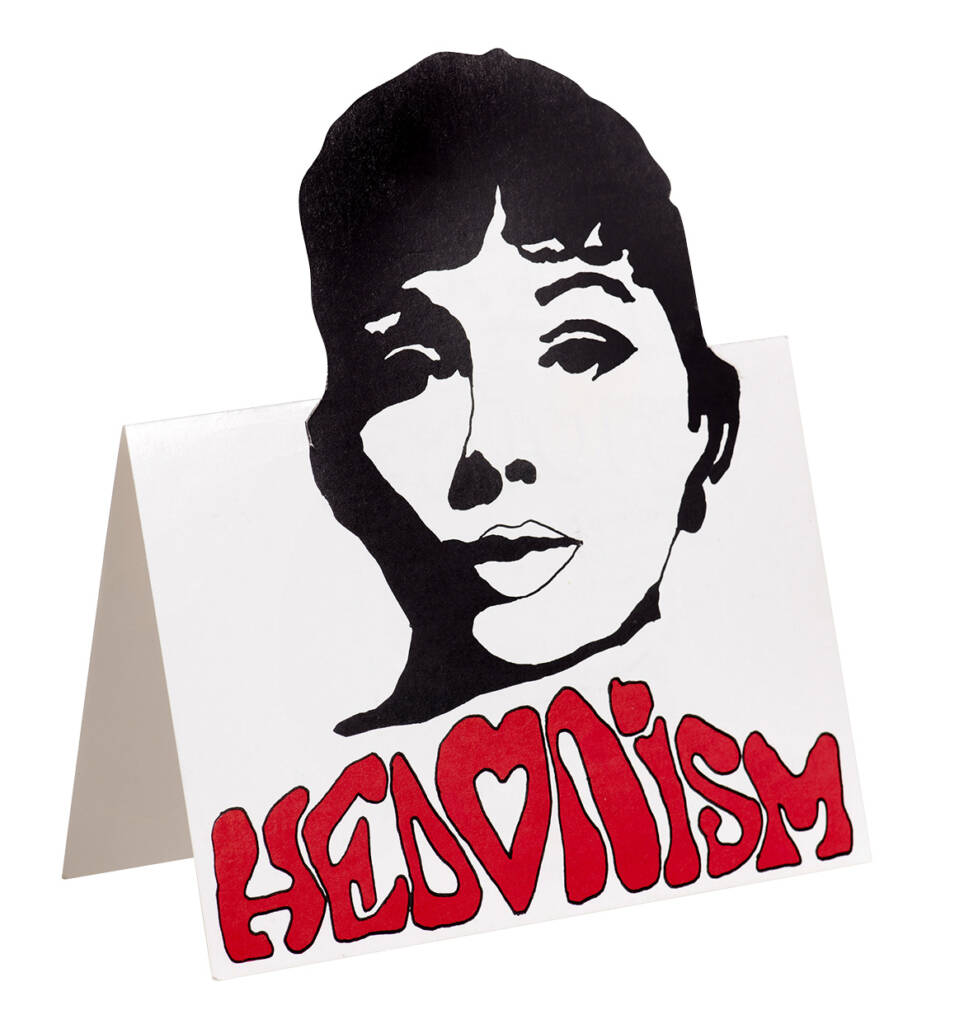
Hedonism
26 March 1988
Alperton Lane, Wembley
Promoters: Alun Gordon, Simon Gordon
Design: Alun Gordon, Simon Gordon, Josh Wilkins
Inspired by my research and project, promoters Simon and Alun Gordon of Hedonism kindly donated a complete set of original Hedonism flyers. I was absolutely thrilled to receive them — owning a full set is a rare privilege, as it’s unlikely I could ever have tracked them all down, let alone justified the cost to my wife. These flyers promoted the legendary warehouse parties held on Alperton Lane.
This particular design, by Josh Wilkins, is a rare gem. Drawing partial inspiration from the cover of Roxy Music’s The Atlantic Years album and an image featured in The Face magazine, the flyer’s fold-out, stand-up construction made it strikingly inventive — well ahead of its time for that early era.
“In ’88 I was wanting to do a flyer as a 7” single and contacted Simon Harris to see if he’d allow me to use his Bass (How Low Can You Go) as a flyer, but he wasn’t up for it. That would have been a fuck-out flyer. The Hedo1 flyer was a beauty. Josh did the front, Alun did the brain and I did the rest. It was a Brainticket! The printers even got involved and came up with the idea of the fold so it could stand up.” — Simon Gordon
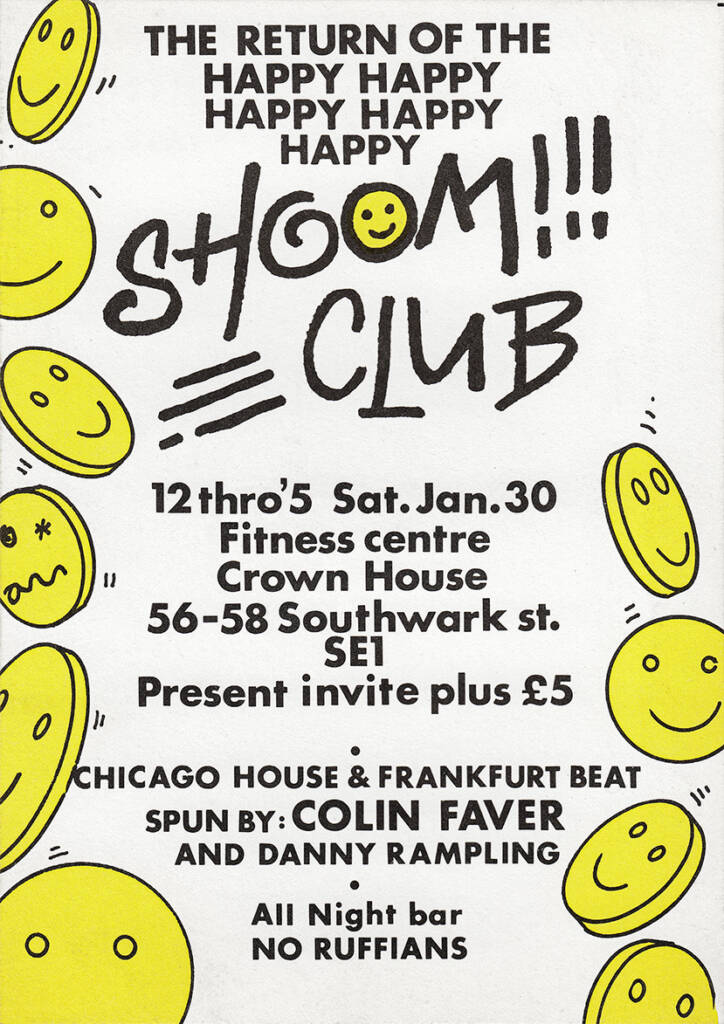
Shoom
30 January 1988
Fitness Centre, Southwark Street, London
Promoters: Danny Rampling, Jenni Rampling
Design: George Georgiou
George Georgiou designed this flyer for Danny and Jenni Rampling’s Balearic house night at the Fitness Centre. Danny had requested that it feature a smiley face. Drawing on the futuristic aesthetic of early computer graphics, George reimagined the smiley as a series of discs tumbling in a cascade — an image many soon interpreted as suggestive of pills. The flyer became the first to feature a smiley, which would go on to become an emblem of the burgeoning underground music scene and, soon after, a symbol of acid house splashed across the tabloid press.
This flyer has always been one of my favourites. Although I’ve been fortunate enough to interview and get to know its designer, George Georgiou, over the years, it long eluded me. Even after offering an eye-watering amount (don’t tell my wife), George didn’t have a spare — or at least couldn’t find one. I waited patiently, hoping one might resurface, and eventually managed to secure a copy from another source connected to the parties back in the day.
“I liked all the 3D CGI graphics that were happening at the time and came up with the idea of smileys in 3D — as discs which then were perceived as tablets or pills, if you prefer… and as it happens, lots of people did.” — George Georgiou
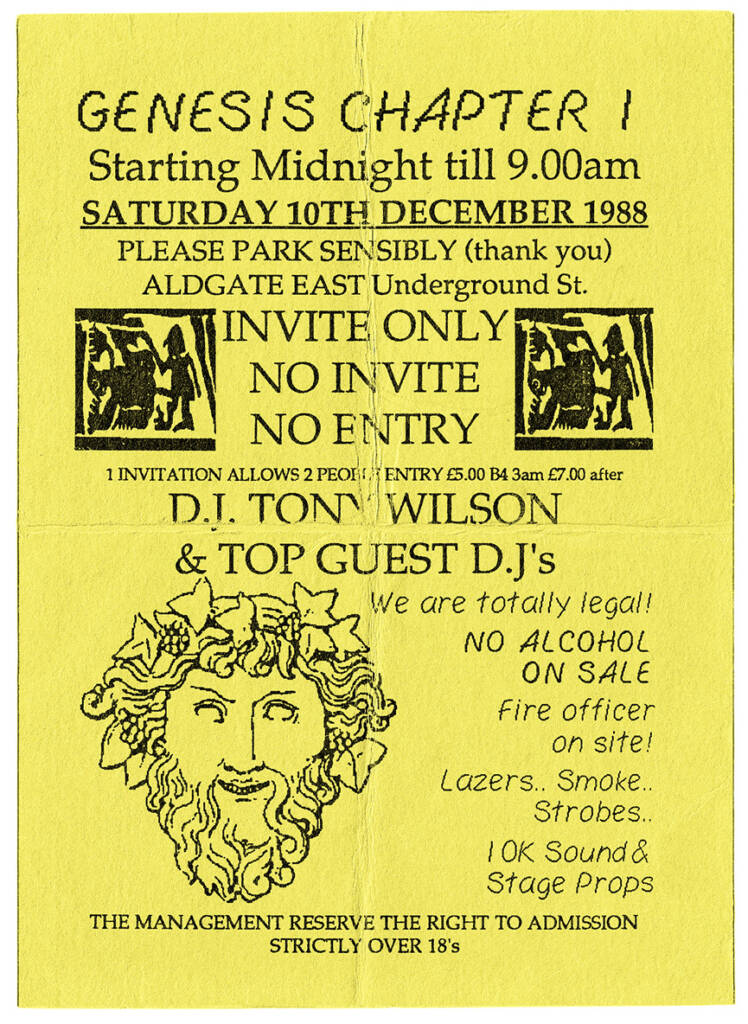
Genesis
10 December 1988
Aldgate, London
Promoters: Andrew Pritchard, Wayne Anthony, Keith Brooks
Wayne Anthony, Andrew Pritchard, and Keith Brooks launched Genesis by taking over a warehouse in East London in late 1988, running events through to the end of 1989. Like many flyers from the illegal parties of that era, the early Genesis designs were modest: A6 in size, printed in black ink on coloured card, featuring a simple logo, text, and a map on the reverse for directions. There were no extravagant promises or psychedelic imagery — just the essential details. They were a means of communication, and that simplicity is precisely why they now hold such an important place in history.
I’m not yet fortunate enough to own this particular piece of house music ephemera, but I do have a small collection of Genesis flyers from 1989. Perhaps one day I’ll get lucky — or win the lottery — and make a collector an offer they can’t refuse. Then again, knowing the collecting community as I do, I suspect no offer would tempt anyone to part with a complete set of those first four Genesis flyers.
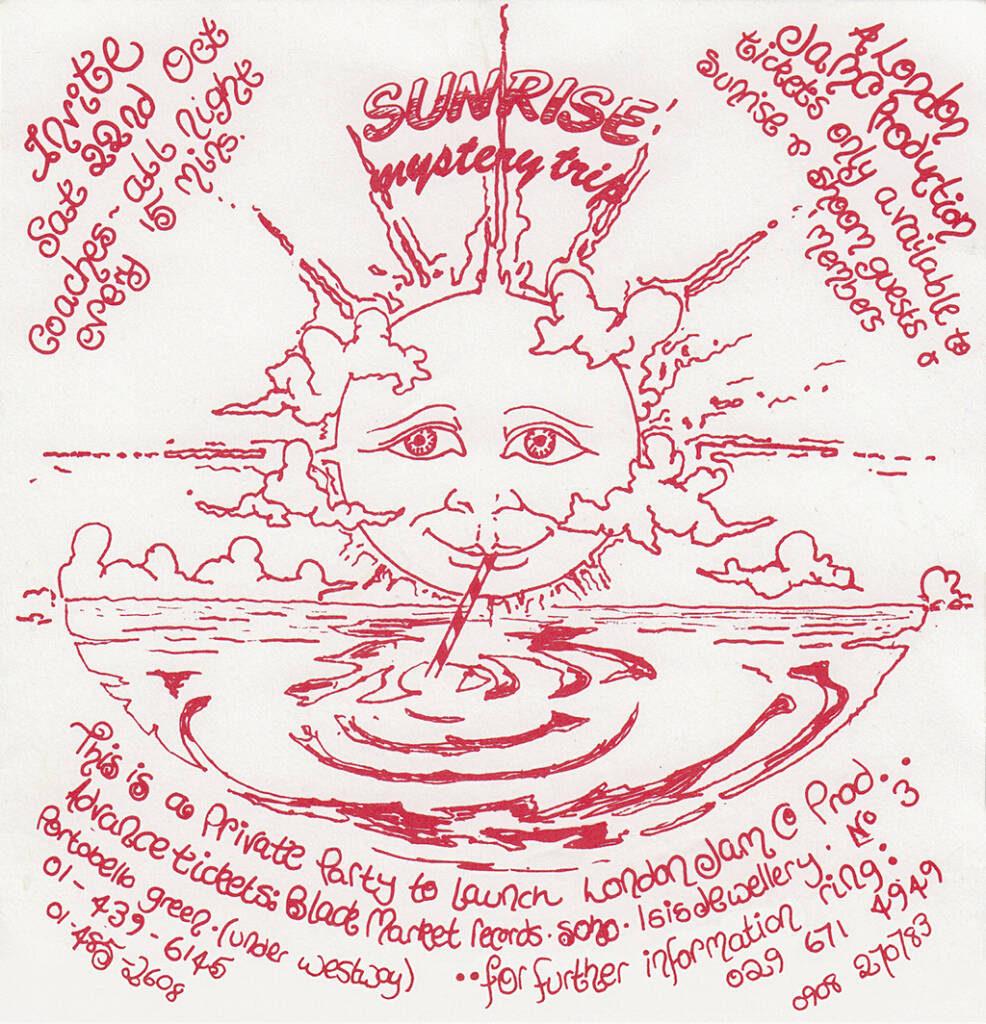
Sunrise Mystery Trip
22 October 1988
Sarratt Equestrian Centre, Buckinghamshire
Promoter: Tony Colston-Hayter
Design: Eddie Richards, Geraldine Sedgwick-Coward, Patrick Woodroffe
The main image, adapted from the work of fantasy artist Patrick Woodroffe, shows a dewy-eyed sun with a straw in its mouth, calmly sipping from the rippling water below. It’s a playful image that perfectly reflects the carefree mood of the early scene. Both the event and this flyer have become woven into rave folklore, and it remains one of the most coveted and iconic flyers among collectors today.
This flyer, like so many others for Sunrise, was created by Eddie Richards and Geraldine Sedgwick-Coward, with some initial input from Tony Colston-Hayter. It’s another I don’t yet have in my collection — but never say never; it’s definitely in my top three most-wanted flyers.
“I came on about six in the morning, after playing two other gigs. As soon as I dropped Kariya, a wave of people went up cheering — like a Mexican wave through the crowd. Thousands of people in a field, going mad for the music. Unforgettable.” — Trevor Fung
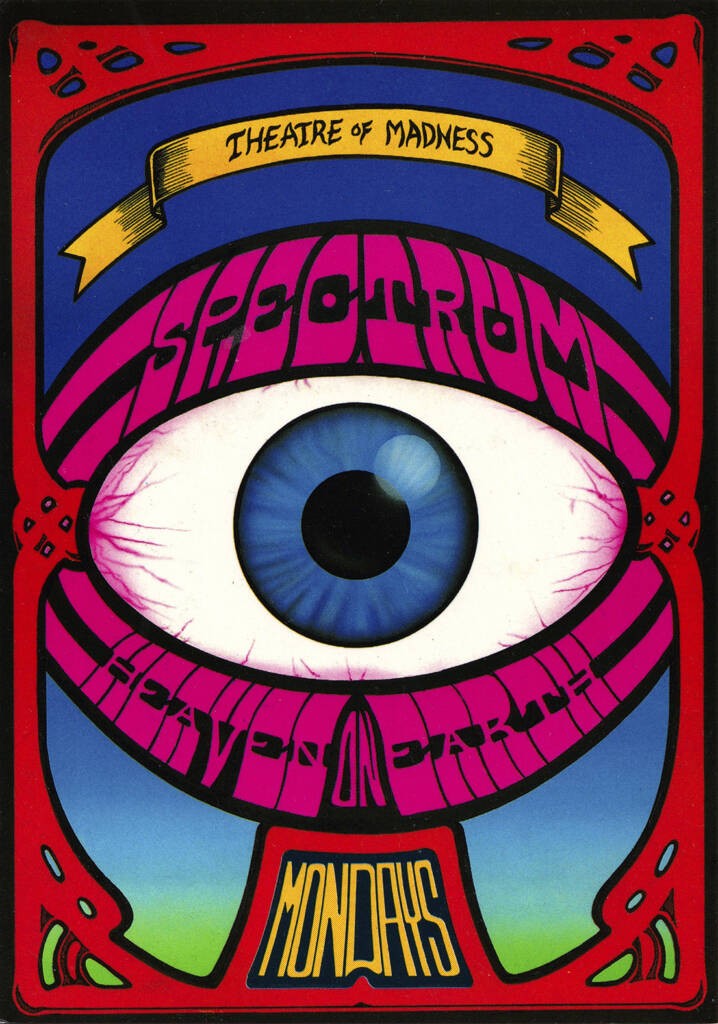
Spectrum
1988 — Heaven, London
Promoter: Ian St Paul
Design: Dave Little
A venture by Ian St Paul, with music provided by Paul Oakenfold, Spectrum was held at Heaven. Despite a slow start — and the fact that it was held on a Monday — it became hugely popular. This Dave Little design is one of the most well-known rave flyers of all time and was featured at the V&A in London, where it is now held permanently. This psychedelic showpiece was partly inspired by Rick Griffin’s work for the Grateful Dead. The rest comes from the genius of Dave’s artistic skills, which produced so much of the classic artwork in acid house.
This particular sale was for the promotional A2 poster version of the usual A6 flyer shown here. Recently, I was lucky enough to win a few of the lots Paul Oakenfold auctioned from his own collection in the US, including an original A3 poster from the opening night on 11 April 1988 — a slightly dog-eared copy that looks as though it once hung on the walls of Heaven nightclub.
“I met up with Paul Oakenfold, Ian St Paul and Gary Haisman. Gary gave me the brief. He said, ‘Dave, I want a fuckin’ great big trippy eye in the middle with the word Spectrum above it and below Heaven on Earth.’ Literally, that’s all he said.” — Dave Little
The Ten Highest-Selling Rave Flyers from 1988–1989 on eBay
- £1,120 – Hedonism, 26 March 1988
- £921 – Shoom Club Saturdays (black on yellow), 1988
- £900 – Shoom Club, 30 January 1988
- £751 – Genesis, 10 December 1988
- £750 – Rave at the Cave, 15 October 1988
- £720 – Sunrise Mystery Trip, 22 October 1988
- £700 – Shoom Club Trance Dance, 28 April 1988
- £695 – Hedonism, 26 March 1988
- £695 – Spectrum Mondays (A2 Poster), 1988
- £511 – Shoom (heart-shaped), 9 November 1988
Disclaimer
This isn’t a price guide — just a snapshot of recorded sales from the past ten years. Flyer values can swing wildly depending on timing, condition, and who’s bidding. One might fetch £500 one year and £50 the next. These figures also don’t include the many private sales that aren’t publicly recorded, so take them all as a rough guide rather than a hard market value.

